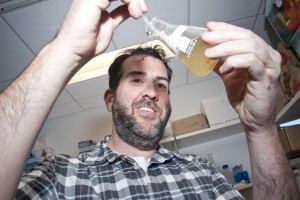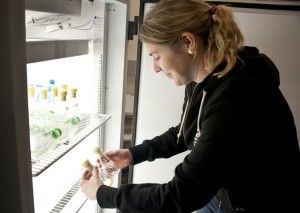CSUN Ecology Team Studies Algae, a Possible Key to Saving Corals From Effects of Global Warming
Fanlike corals that once swayed smoothly with the currents in the Florida Keys, ornamented with shocks of vibrant color, now stick out from the seabed in rigid, skeletal structures completely bleached of life. This is the current state of many corals that cannot withstand the rising temperatures of the world’s oceans as global warming takes effect.
But California State University, Northridge ecology professor Casey terHorst is searching for the few organisms that are still thriving in those warm waters.

CSUN ecology professor Casey terHorst retrieves a sample of symbiotic algae from a test beaker in his lab. Photo by David J. Hawkins.
Soft gorgonian corals carry microscopic symbiotic algae, known as Symbiodinium Antillogorgium, which in some cases have the ability to withstand hotter climates. These small creatures may hold the key to saving the lives of soft corals across the world’s ocean floors, according to terHorst.
“We talk about climate change — it affects corals when the temperature gets hot, because they lose the symbionts,” he explained. “This is called coral bleaching. The corals can survive for a short time [without the symbionts] — maybe a month — but eventually they will starve to death.”
terHorst said the most important element of the relationship between the coral and the algae is their evolutionary lifespans.
“Corals can sort of live indefinitely,” he said. “They cannot evolve quickly. But for symbionts, the generation is about a day. They reproduce really quickly. Corals might not adapt [to climate change], but these symbionts might.”
Using part of an $873,000 National Science Foundation grant, terHorst and his team of three undergraduates and two graduate students are studying 10 different genotypes of algae. The genotypes are held in beakers full of a solution mimicking seawater, then placed in two different temperature-controlled chambers for six weeks. By the end of the six-week period, the team will observe which samples are still doing well in hotter temperatures.

CSUN graduate ecology student Shannon Bayliss collects beakers full of algae from a temperature-controlled chamber. Photo by David J. Hawkins.
If the experiment shows that some algae survive, the next step would be to place them on symbiotic soft corals and observe if the two can survive together in warmer waters, terHorst said.
“Coral reefs everywhere are in big trouble,” he said. “I hope at the end of the experiment, we have some evidence that these symbionts can evolve in response to climate change.”
Ecology graduate student Shannon Bayliss is using the experiment to work on her thesis. The most rewarding part of coral research is its potential to have direct applications for conservation, she said.
“A lot of research we do has application, but you have to reach far to get it,” Bayliss said. “But this one has direct applications that we could potentially see. A lot of projects you work on don’t have that kind of satisfaction.”
Fellow ecology graduate student Zoë Scott said she is hopeful that looking at genetic diversity in the algae will lead to saving soft corals in warming waters.
“It’s interesting that most people don’t think about genetic and genotypic diversity when they think of coral reefs and their future,” she said. “It’s crazy to think that something so small could have such a huge impact on the survival of a species. Maybe all is not lost for coral reefs.”

 experience
experience